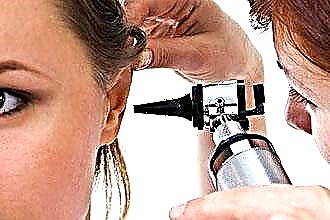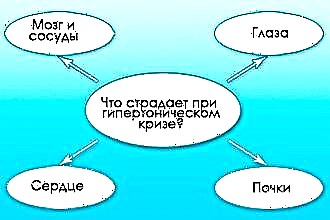Turundas - gauze or cotton tourniquet, which is used to introduce into hard-to-reach cavities - the external auditory canal, nasal passages, fistulas, etc. Tampons are made exclusively of hygroscopic materials, which facilitates the process of cleaning the cavities from serous and purulent accumulations. They can be impregnated with medicinal solutions with disinfecting, anti-inflammatory and regenerating properties.
Turunda in the ear is intended to eliminate local manifestations of otitis externa and myringitis. Regular use of tampons helps to cleanse the ear canal of purulent exudate and pathogens. With the help of gauze and cotton tourniquets, you can make anti-inflammatory lotions that are relevant in the treatment of diffuse and limited otitis media.
Purpose of turunda

Hygroscopic tampons are tight bundles twisted in a spiral. Sterile cotton wool, cotton pads, gauze or bandages are used as a raw material for the manufacture of turunda. A simple device is moistened in a medicinal solution and inserted into the inflamed ear to accelerate the regression of catarrhal processes in the affected tissues. According to otolaryngologists, gauze and cotton tourniquets are more effective in treating otitis media than ear drops.
The drug-soaked tampons are constantly in contact with the inflamed mucous membranes, which speeds up the healing process. The systematic use of turunda contributes to:
- stretching purulent masses;
- elimination of liquid exudate;
- normalization of the outflow of serous discharge;
- regression of inflammatory processes;
- removal of puffiness from mucous membranes;
- restoration of ventilation function.
The key advantage of medical tourniquets is the large area of interaction of the drug with inflamed tissues. It is for this reason that they are often used for the preparation of in-ear lotions with antiphlogistic and disinfecting effects.
Cotton wool turundas
How to make a turunda in the ear? For the preparation of tampons, it is advisable to use sterile cotton wool. Thus, it is possible to prevent the penetration of pathogens into the external auditory canal. To prepare the harnesses, you should:
- roll a tight rope from a piece of cotton wool no more than 6-7 cm long;
- bend the resulting tampon in half and twist the halves together;
- the thickness of the turunda should not exceed 6 mm.
The easiest way to make turunda is with a toothpick. To do this, a piece of cotton wool is wound on a wooden rod, after which a toothpick is carefully pulled out. To make the tourniquet stiff, we twist it in a spiral.
It is most convenient to form hygroscopic swabs from cotton pads. To do this, one disc is divided into two thinner discs. Each of them is rolled up into a tube and twisted a little in a spiral so that the roller turns out to be quite dense. Pads made of cotton pads are less loose, so the remnants of cotton very rarely remain in the ear canal after hygiene procedures.
Gauze turundas
During the tampon treatment of otitis externa, a gauze turunda can be used in the ear. How to make a gauze swab? To create a tourniquet, sterile gauze or inelastic bandages are used. They are highly hygroscopic, so they prevent the accumulation of exudate in the ear canal.
Important! Tight tamponade can cause the growth of granulations in the affected tissues.
In the process of forming a turunda, you need to adhere to the following algorithm:
- cut the bandage into longitudinal strips up to 8 cm wide;
- wrap the ends of the bandage on both sides inward by 1 cm;
- fold the workpiece lengthwise on both sides so that the ends meet in the central part of the segment;
- fold the bandage again in the same way;
- Twist the bandage tightly to make a gauze roll no more than 7 mm in diameter.
 The length of the finished tampon should be at least 6 cm. For tampon treatment of children under 7 years of age, the diameter of the tourniquet should not exceed 5 mm.
The length of the finished tampon should be at least 6 cm. For tampon treatment of children under 7 years of age, the diameter of the tourniquet should not exceed 5 mm.
When wet, the gauze roll becomes too soft and difficult to insert into the ear canal. For this reason, experts recommend injecting it dry and only then applying a medicinal solution to the tourniquet.
Application technique
Local treatment of most ear pathologies involves the introduction of cotton or gauze swabs into the ear canal. With their help, the necessary hygienic and therapeutic measures are carried out to help cleanse the outer ear from serous and purulent masses. In this case, it is necessary to take into account several generally accepted rules for the use of ear turundas:
- before the procedure, it is advisable to clean the ear canal from sticky sulfur using a gauze swab dipped in 3% hydrogen peroxide;
- do not insert cotton and gauze bands deep into the auditory canal, as this can damage the ear membrane and impair blood microcirculation;
- the length of the outer part of the tampon should be at least 1 cm for easier removal after tamponing;
- when using medicinal solutions, turundas should be barely wet in order to exclude the possibility of moisture getting into the ear;
- the tampon is inserted into the ear canal with a rotational movement, avoiding tamping of the material;
- It is advisable to wrap cotton swabs with gauze before insertion in order to eliminate the likelihood of the penetration of fibrous matter deep into the ear.
Before wetting the tampons, the medicinal solution used for medical purposes must be warmed up to 37 degrees. Thus, it is possible to prevent the narrowing of the vessels in the ear canal, which will contribute to the early penetration of the components of the agent into the inflamed tissues.
Features of therapy
Before doing turunda in your ears, you need to consult with an otolaryngologist. Ignoring the peculiarities of the use of external drugs can lead to allergic reactions, inflammation and even greater tissue edema. To eliminate the likelihood of complications, you need to pay attention to the following nuances:
- tamponing is performed no more than 3 times a day;
 the duration of the use of tampons with drops cannot exceed 4-5 hours, with ointments - 8 hours;
the duration of the use of tampons with drops cannot exceed 4-5 hours, with ointments - 8 hours;- it is highly undesirable to use tourniquets soaked in an alcohol solution in the presence of mechanical damage in the ear canal.
When treating children under the age of 3, ear tampons are used exclusively for cleaning the ears. It is impossible to leave them for a long time in the auditory canal, which is due to the high risk of developing a pathogenic flora against the background of reduced body resistance.
In addition, local irritants should not be used to treat children under 12 years of age. This is due to the hypersensitivity of the skin and a tendency to allergic reactions.

 the duration of the use of tampons with drops cannot exceed 4-5 hours, with ointments - 8 hours;
the duration of the use of tampons with drops cannot exceed 4-5 hours, with ointments - 8 hours;

